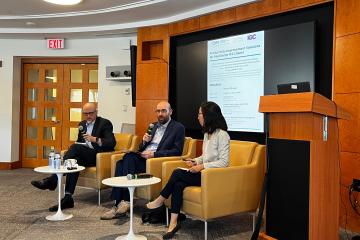
Supporting firm growth through consulting and business training

Résumé
Economists have long identified large differences in productivity between countries and between firms. One potential explanation for the persistent gap is that some firms have better management practices than others. Observational data find that firms that invest in management best practices experience improved productivity [7]. If management practices play an important role in firm growth, then giving firm owners access to subsidized business training services and consulting could be one way to support their growth. Business training programs tend to teach standard best practices in a classroom setting, such as record keeping and conducting market research, while consultants work closely with firms to identify areas for potential improvement and to support the implementation of recommended actions.
Results from five randomized evaluations targeting firms with more than five employees found that consulting and business training programs often increased firm productivity, sales, profits and likelihood of survival. In contrast, results from a separate review of 22 randomized evaluations on microenterprises (businesses with less than five employees) found that business training did not necessarily translate to changes in profits. Given the impacts on firm performance from business training and consulting programs on larger firms, an open question that remains is why firms choose not to use these programs or hire consultants themselves. Time constraints and uncertainty about the benefits seem to decrease firms’ use of the services. More research is needed to understand how to encourage more providers to offer these services and how to encourage firms to use them.
| Mexico | India | Tanzania | Vietnam | Colombia | |
|---|---|---|---|---|---|
| Business practices | ↑ | ↑ | ↑ | ↑ | ↑ |
| Productivity | ↑ | ↑ | ↑ | ↑ | — |
| Business performance (Profits or Sales) | — | No data | ↑ | ↑ | — |
| Job Creation | ↑ | — | — | — | ↑ |
Note: Green (red) arrows represent statistically significant positive (negative) differences in outcomes between the treatment and comparison groups at the 90 percent confidence level or higher, dashes represent no statistically significant difference. See below for more details.
Résultats
Four evaluations found that business training and consulting programs increased productivity, because firms applied many of the management practices that the programs recommended. However, not all the practices that were recommended were applied. Instead, firms used those that were thought to have the quickest impact on their profits, such as marketing efforts [2] [3] [4] [6] and the use of formal accounting practices [3] [4] [6]. For example, firms in Colombia were offered consulting either individually or as a group to improve their processes in logistics, human resources, finance, marketing and sales, and production. Consulting increased the use of management practices by 8 to 10 percentage points (14 to 18 percent increase), with the largest improvements seen around defining strategic goals and objectives and the smallest improvements in human resource practices. The demonstration aspect of consulting programs may have been key to the successful adoption and application of management practices.
Despite large gains in productivity, take-up of consulting and business training programs was low in some contexts, driven in part by uncertainty about the potential benefits of adopting new practices [1] [3] [5]. For example, in one evaluation in India, only 50 percent of large-scale textile firms agreed to commit senior management time to a consulting program despite the service being offered for free. The consulting program went on to generate an estimated 17 percent increase in productivity in the first year for participating firms [1]. To understand why firms did not use consulting or business training services despite large potential increases in productivity, researchers conducted follow-up surveys in three randomized evaluations [1] [3] [6]. Financial constraints, time constraints (particularly from senior management), and uncertainty about potential benefits to adopting business best practices were commonly cited reasons for low demand.
In line with firms’ uncertainty about potential benefits, firm owners experimented with implementing business best practices, and the benefits to consulting and business training programs increased over time. Four evaluations found that impacts on firm outcomes were larger in the medium to long run (two to five years later) compared to in the short run (one year later) [1] [2] [3] [4] [5]. Firm owners first tested new practices before gradually rolling them out across the firm. Over time, as business performance improved, more complex improvements were then introduced. Practices that were not implemented or were discarded over time were reportedly due to the perception that it was not useful. This suggests that while firm owners may initially be skeptical about the benefits of implementing recommended practices, they incorporate the changes as the benefits are realized. More research is needed to understand how to effectively communicate the potential benefits of training and whether this can affect firms’ decision to engage with the market for business training services.
a. Abdul Latif Jameel Poverty Action Lab (J-PAL). 2019. "Teaching Business Skills to Support Microentrepreneurs." J-PAL Policy Insights. Last modified Dec 2019. https://doi.org/10.31485/pi.2573.2019
b. In Tanzania and Vietnam, the authors used value added as an alternative way to measure productivity and sales. Mexico: Management consulting services had no impact on the number of workers one year later. However, using administrative data, researchers found large increases in the number of employees five years after the consulting program.
Abdul Latif Jameel Poverty Action Lab (J-PAL). 2019. "Supporting firm growth through consulting and business training." J-PAL Policy Insights. Last modified December 2019. https://doi.org/10.31485/pi.2594.2019
Bloom, Nicholas, Eifert, Benn, Mahajan, Aprajit, McKenzie, David, and John Roberts, 2013.
"Does Management Matter? Evidence from India," The Quarterly Journal of Economics, Oxford University Press, vol. 128(1), pages 1-51. Research Paper | J-PAL Evaluation Summary
Bloom, Nicholas, Mahajan, Aprajit, McKenzie, David, and John Roberts. “Do Management
Interventions Last? Evidence from India,” NBER Working Paper 24249, 2018. Research Paper | J-PAL Evaluation Summary
Bruhn, Miriam, Dean Karlan, and Antoinette Schoar, "The Impact of Consulting Services on
Small and Medium Enterprises: Evidence from a Randomized Trial in Mexico," Journal of
Political Economy 126, no. 2 (April 2018): 635-687. Research Paper | J-PAL Evaluation Summary
Higuchi, Yuki, Mhede, Edwin P., and Tetsushi Sonobe. “Short- and Medium-Run Impacts of
Management Training: An Experiment in Tanzania,” World Development 114 (2019) 220-236.
Research Paper
Higuchi, Yuki, Hoang Nam, Vu, and Tetsushi Sonobe. “Sustained Impacts of Kaizen
Training,“ Journal of Economic Behavior and Organization, Volume 120, December 2015,
Pages 189-205. Research Paper
Iacovone, Leonardo, Maloney, William and David McKenzie. “Improving Management with
Individual and Group-Based Consulting: Results from a Randomized Experiment in Colombia,“
Working Paper, 2018. Research Paper
Bloom, Nicholas, Sadun, Raffaela, and Van Reenen, John. “Management as a Technology?”
NBER Working Paper No. 22327, 2017. Research Paper
Macchiavello, Rocco, Rabbani, Atonu, and Christopher Woodruff. “The Market for Training
Services: A Demand Experiment with Bangladeshi Garment Factories,” American Economic
Review: Papers and Proceedings 2015 105(5): 300-304. Research Paper
Related Content

Increasing Firm Productivity through Management Consulting Services in India

Market access: Connecting firms and entrepreneurs to markets to spur business and job growth
